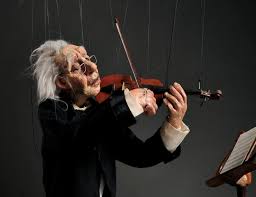
27 Sep The Palm: Cashore Marionettes, 10/2
Reserved seating tickets for The Cashore Marionettes at Telluride’s Michael D. Palm Theatre on Sunday, October 2, 4 p.m., are available online at www.telluridepalm.com; general admission tickets can be purchased at the door the day of the event. Ticket prices are $8 for students and children; $12 for adults. For questions about the performance call 970.369.5673.

As part of the PalmKidz programming at the Michael D. Palm Theatre, The Cashore Marionettes take the stage on Sunday, October 2, 4 p.m., to present “Simple Gifts,”a 60-minute family-friendly show. The show is an encore for the talented artist who first came to The Palm in 2013.
“Simple Gifts” is a series of touching portrayals and poignant scenes from everyday life set to stunning music by such composers as Vivaldi, Strauss, Beethoven, and Copland.
Through a combination of virtuoso manipulation, beautiful music, theatrical illusion, and artistic insight, the original vignettes presented in “Simple Gifts” provide an entertaining and sensitive vision of what it is to be human. The performance explores a range of emotions with characters and actions that are amazingly convincing. The marionettes are engineering marvels; the quality of movement is extraordinary.
A marionette is a puppet controlled from above by strings. The word “marionette” is derived from “Mary” and originated in Europe in the Middle Ages when nativity plays were performed using the stringed puppets, though marionettes themselves are thought to be much older in origin.
In the U.S., puppet shows are widely considered exclusively for children, however throughout the rest of the world, puppet and marionette plays are classically adult entertainment.
Cashore created his first marionette from clothespins at age 11. He used wood, string and a tin can. While playing with this crude puppet, he claims to have been startled by the sudden, though momentary sensation his creation was alive. The illusion had nothing to do with the appearance of the marionette and everything to do with the quality of the movement.
After graduating college, Cashore made his second marionette. He remembered that first marionette from childhood and thought he would try to make a puppet that could sustain and extend that sensation of being alive. He quickly discovered that in order to have the fluid motion he sought, he would have to create his own control designs. For the next 19 years, while pursuing a career in oil painting, Cashore experimented with the construction of the marionettes, devising totally new control mechanisms.
During the late 1980s, Cashore had a breakthrough. He had always admired Ralph Vaughan Williams’ “The Lark Ascending” and decided to make a puppet which would convincingly “play” the violin solo note for note.
“It seemed almost impossible to get the quality of movement that I wanted,” Cashore explains. “But once I began to solve the technical problems and gain subtle control of the marionette body, I saw there was the possibility for greater depth of expression with the marionettes.”
That puppet, Maestro Janos Zelinka, was the turning point in Mr. Cashore’s career and became the impetus for his present productions.
Cashore has been performing full-time since 1990 across North America, Europe, and Asia. He has received numerous awards including a Pew Charitable Trusts’ Fellowship for Performance Art, based upon his artistic accomplishment. He has also earned a Henson Foundation Grant, an award intended to help promote puppetry to adult audiences. Mr. Cashore has been awarded the highest honor an American puppeteer can receive, a UNIMA Citation of Excellence. UNIMA states that Citations are “awarded to shows that touch their audiences deeply; that totally engage, enchant and enthrall.”
For a preview of the show, watch this video.


Sorry, the comment form is closed at this time.